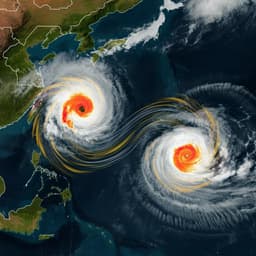
Earth Sciences
Climatic and tectonic drivers shaped the tropical distribution of coral reefs
L. A. Jones, P. D. Mannion, et al.
This groundbreaking study by Lewis A. Jones and colleagues explores how climate and palaeogeography have historically influenced coral reef distribution over geological timescales. Discover how a wider tropical belt supported diverse reef habitats in the Mesozoic era, and why future global warming may not be enough for coral reefs to adapt to rapid climate changes.
Playback language: English
Introduction
Warm-water coral reefs, despite covering less than 0.1% of the ocean's surface, are among the most biodiverse marine ecosystems. Their present-day distribution is restricted to tropical and subtropical latitudes (~34°N–32°S), primarily due to minimum sea surface temperature tolerances (~18°C). This latitudinal constraint also significantly impacts the distribution and diversity of many reef-associated organisms, creating a steep latitudinal biodiversity gradient. The Indo-Australian Archipelago is a particularly significant biodiversity hotspot, harboring approximately 75% of zooxanthellate corals.
Fossil evidence suggests that coral reefs had a less tropical distribution in the geological past, extending to higher latitudes during certain periods. Several factors, both abiotic (climate) and biotic (competition, adaptation), have been proposed to explain these shifts. Past latitudinal expansions are often linked to a widening of tropical conditions; however, plate tectonics, by influencing continental distribution and shallow marine substrate availability, are also crucial factors. The interplay of climate and substrate availability in shaping coral reef distribution remains unclear, particularly regarding the extent to which these factors explain the observed tropically-skewed distribution today.
Understanding the influence of these drivers on climatically suitable habitat area is essential, as past latitudinal shifts in habitat availability likely shaped the distribution of reef-associated biodiversity. The relationship between reef habitat area and the biodiversity of associated organisms in the present day, along with the role of ancient reefs as biodiversity sources ('cradles'), suggests that past habitat shifts are relevant. The current rapid deterioration of coral reefs due to rising sea surface temperatures and ocean acidification underscores the urgency of understanding their response to climate change.
Past studies investigating pre-Quaternary reef distribution and abiotic controls found weak correlations, likely due to the patchy fossil record, preferential sampling in the Northern Hemisphere, and biases related to economic factors influencing research locations. These biases hinder a full understanding of the macroevolutionary patterns in ancient reefs. This study addresses these limitations by combining habitat suitability modelling and Earth system modelling to infer the spatiotemporal distribution of suitable habitat for coral reefs over the last ~247 million years, offering insights into the roles of climate and palaeogeography.
Literature Review
Previous studies on the distribution of coral reefs in the geological past have yielded mixed results. Some have highlighted the importance of climatic factors in shaping reef distribution, particularly the expansion and contraction of tropical and subtropical conditions (Kiessling, 2001; Perrin & Kiessling, 2010). Others have emphasized the role of plate tectonics and the resulting changes in continental configurations and the availability of shallow marine substrates (Crame & Rosen, 2002; Leprieur et al., 2016). However, these studies often faced challenges due to the inherent limitations of the fossil record, such as sampling bias (Kiessling, 2005; Jones et al., 2021) and inconsistencies in palaeoclimatic reconstructions (Jones & Eichenseer, 2021). The limited spatial and temporal resolution of the available data has made it difficult to definitively determine the relative importance of climate versus tectonics in shaping the long-term distribution of coral reefs.
Methodology
This study employed a novel approach combining habitat suitability modeling (HSM) and Earth system modeling to investigate the drivers of coral reef distribution over the last ~247 million years. The HSM used MaxEnt, calibrated with present-day warm-water coral reef occurrence data from ReefBase and climatic layers from the HadCM3BL-M2.1aE Earth system model. The model incorporated key climatic variables: mean maximum and minimum sea surface temperature, and mean maximum and minimum insolation. The model's discriminatory capacity was assessed using the Area Under the Curve (AUC) and continuous Boyce index.
The model was then projected onto stage-level estimates of past abiotic conditions derived from the HadCM3BL-M2.1aE model, hindcasting the distribution of climatically suitable habitat across various geological stages from the Anisian (Middle Triassic) to the Piacenzian (latest Neogene). The accuracy of these hindcasts was evaluated against a compiled dataset of 535 fossil coral reef localities from the PaleoReef Database (PARED) and Paleobiology Database (PBDB). To account for potential uncertainties in the palaeorotations of fossil locations, a one-cell buffer was included as well.
Statistical analyses, including Wilcoxon rank-sum tests, compared the predictive performance of the model against random spatial point generation to determine whether the model's predictions were significantly better than random chance. Both binary threshold selection ('MaxSSS' and 'Least Training Presence') were compared and explored. Multivariate Environmental Similarity Surface analyses were used to identify areas with environmental conditions outside the model's calibration range. The spatiotemporal patterns of suitable habitat were analyzed by calculating the weighted centroid of suitable habitat area, the palaeolatitudinal reef zone, and the areal extent of suitable habitat at both global and latitudinal scales. Ordinary least-squares regression examined the relationship between the number of fossil reef sites and the availability of climatically suitable habitat. All simulations and analyses were performed using R version 4.0.3. The HadCM3L climate model used CO2 concentrations held constant for broad climate states (icehouse vs. greenhouse), acknowledging this simplification over more nuanced, stage-on-stage differences.
Key Findings
The model demonstrated good discriminatory capacity (AUC = 0.856, Boyce index = 0.988) and moderate to high predictive performance for fossil reef localities (60-87% accuracy, increasing to 62-90% with a one-cell buffer). The predictive success was significantly better than random expectations. Most false negatives were attributed to fossil localities intersecting with simulated sea surface temperatures below the present-day tolerance (<18 °C), potentially reflecting a cold bias in the paleoclimatic simulations. Conversely, some localities intersected with maximum sea surface temperatures exceeding present-day values, suggesting corals may have occupied a broader climatic niche in the past.
Analyses of the model's predictions revealed a long-term equatorward shift in the centroid of suitable habitat in both the Northern and Southern Hemispheres, particularly pronounced since the Priabonian (late Eocene). In the Northern Hemisphere, this shift resulted from a decline in suitable habitat at higher latitudes (30-50°N) due to decreasing sea surface temperatures. The Southern Hemisphere shift was driven by an increase in suitable habitat in the southern tropics/subtropics due to an expansion of shallow marine substrate associated with the tectonic evolution of the Indo-Australian Archipelago.
A significant finding is that for much of the Mesozoic and early Cenozoic, suitable habitat area was less skewed toward the tropics than it is today, with a notable exception in the earliest Cretaceous, characterized by reduced shallow marine substrate and potentially cooler temperatures. The areal extent of climatically suitable habitat varied throughout the time series, with peaks in the Late Jurassic and Late Cretaceous-Eocene, and declines across the Jurassic/Cretaceous boundary and from the Priabonian onwards. Notably, no significant relationship was found between the number of fossil coral reef sites and the availability of climatically suitable habitat.
Discussion
The results suggest that climate and palaeogeography played key roles in shaping coral reef distribution over the last ~247 million years. Coral reefs generally tracked major latitudinal shifts in tropical and subtropical conditions. The increasing tropical concentration of suitable habitat from the late Paleogene reflects a combination of global cooling and an expansion of tropical shallow marine substrate resulting from tectonic activity, particularly the evolution of the Indo-Australian Archipelago. This finding supports the importance of both climate and tectonic processes in shaping biodiversity patterns over geological timescales. The observed equatorward shift in suitable habitat correlates with the steepening of the latitudinal biodiversity gradient in reef-associated taxa from the late Paleogene. The earlier Mesozoic and early Cenozoic likely exhibited flatter gradients, coinciding with a broader reef zone. The high predictive capacity of the model, despite limitations, supports its use in future studies to identify areas for fossil prospecting and to provide insights into the future distribution of coral reefs under climate change scenarios.
Conclusion
This study demonstrates the combined influence of climate and tectonics on the distribution of coral reefs over geological timescales. The model's strong predictive power highlights the importance of both abiotic and geographic factors in shaping coral reef ecosystems. While past coral reefs adapted to changing climates over millions of years, the current rate of anthropogenic climate change is likely to exceed their capacity for adaptation. Future research could incorporate more detailed palaeoclimatic data, explore the role of other ecological variables, and refine the models to further improve predictions and our understanding of coral reef resilience.
Limitations
This study has several limitations. The climate simulations employed idealized CO2 concentrations, particularly for pre-Cenozoic periods, neglecting within-stage variability. The choice of climate model (HadCM3L) might influence the results, although inter-model differences are unlikely to alter the overall conclusions. The spatial resolution (1° x 1°) might bias estimates of suitable habitat area, particularly in regions with complex bathymetry. The number of fossil reef localities varied across stages, limiting the evaluation of specific stage-level hindcasts. Finally, the model assumes that all climatically suitable habitat was accessible and occupied, neglecting dispersal limitations and other ecologically relevant variables such as upwelling and nutrient concentrations due to data limitations.
Related Publications
Explore these studies to deepen your understanding of the subject.







